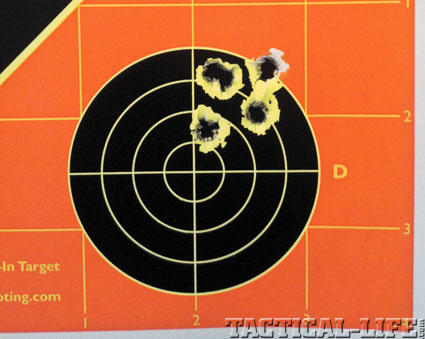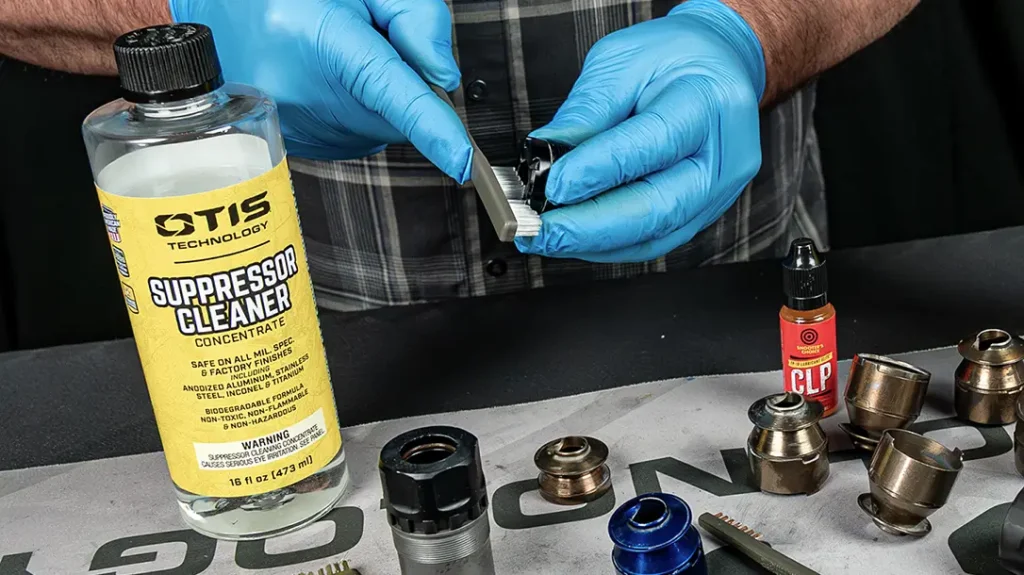Raging bullpup! Steyr Arms’ AUG/A3 SA is ready for CQB yet still maintains a 16-inch barrel for better ballistics. Shown with a Trijicon ACOG with Docter sight.
Let’s admit it. The AR platform is an iconic design. Despite having some very vocal detractors, few would argue that it was not a revolutionary, game-changing weapon platform. But even the radical AR conforms to “traditional” long gun design—namely having its action and magazine forward of the pistol grip and buttstock. For the LE officer wanting to take a step further into non-conformist, advanced weapon design, the “bullpup” is the next logical step.
The bullpup turns long gun design on its head by locating the action in the buttstock portion of the rifle, thereby shortening the overall length of the firearm while still retaining a reasonable barrel length to maintain ballistic performance. But, the bullpup has a complicated history as a military/tactical arm. Despite its numerous advantages, it has always seemed to struggle to catch on in mainstream weapon design. However, there is one very bright success story in the convoluted history of the bullpup—the 5.56x45mm Austrian Steyr AUG.
Adopted by the Austrian military in 1977 as the StG 77, the Armee Universal Gewehr (or AUG) represented the “mainstreaming” of the bullpup design, having been developed and manufactured by the highly respected armsmaker Steyr Mannlicher. In addition to proving that the advantages of the bullpup design were suitable to a military role, the AUG also established a few other benchmarks for modern military weapon design. Most notable of these was the employment of an integrated low-power optic, as well as the extensive use of synthetic and lightweight materials (continuing the trend popularized by the AR beginning in the 1950s). Also of note regarding the design is its modularity—its barrel can be easily swapped out in a matter of seconds. To further burnish the credentials of the AUG, the Australians adopted their own licensed version of the rifle, dubbed the F88 Austeyr series. The Malaysians also adopted there own licensed version of it, and it has been adopted by numerous armed forces around the world ranging from locations such as Ireland to New Zealand.
Advertisement — Continue Reading Below
The AUG even made it to our shores, with semi-automatic variants being offered for civilian sale. This gave shooters from the U.S. a chance to own their own version of this highly influential and capable design. However, import restrictions enacted in the late 1980s (and follow-up “reinterpretations” of importation laws) effectively banned the sale of this classic Austrian-made 5.56mm on our shores. Thankfully, through the efforts of Steyr Arms, Inc. (the U.S. arm of Steyr Mannlicher that is based in Trussville, Alabama), a semi-automatic AUG is now being manufactured here in America for sale to U.S. customers.
Gun Details
The 5.56x45mm AUG/A3 SA from Steyr Arms is a U.S.-manufactured version of the Austrian AUG. At its core, the AUG/A3 SA is a gas-operated, semi-automatic carbine that employs an adjustable, short-stroke gas piston system with a two-position gas regulator. It utilizes a cold-hammer-forged, chrome-lined, 16-inch barrel. The overall length of the AUG/A3 is 28.15 inches, and its weight empty is 8.15 pounds.
Advertisement — Continue Reading Below
The U.S.-made AUG/A3 takes advantage of Steyr Mannlicher’s decades of refinement to the original Austrian design, which have been manufactured in three primary configurations: the A1, the A2 and the A3. The A1 is a classic version of the design, featuring an integrated 1.5X optic built into the carrying handle, “tulip”-style muzzle brake and folding foregrip. The A2 replaced the integrated optic with a short strip of Picatinny rail to allow the use of a variety of optics. The Austrian Steyr A3 continued the trend of swappable optics with a larger strip of Picatinny rail as well as a supplemental short strip on the right side of the receiver. Also changed out was the “tulip” brake, and the foregrip can be replaced with an optional under-barrel Picatinny rail system. A bolt release lever was also added.
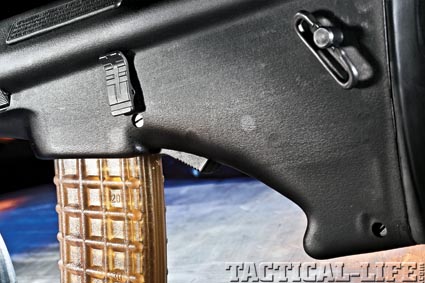
The AUG/A3 SA features an external bolt release lever located on the left side of the stock, above and to the rear of the magazine well.
The new U.S.-made AUG/A3 from Steyr Arms actually combines elements of the A1, A2 and A3. It features a “tulip” brake and the original-style folding foregrip of the series, but also has the large, 12-inch strip of Picatinny rail on top and the supplemental 3-inch strip of rail offset on the right side of the receiver of the A3. It also employs the A3’s bolt release lever on the left side of the stock. The result is a carbine that combines the most advanced features of the Austrian A3 AUG, but with an overall look that recalls the classic profile of the A1 and A2 variants.
Advertisement — Continue Reading Below
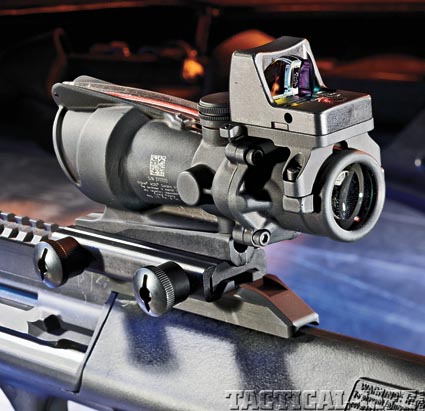
The top rail of the AUG/A3 SA is 12 inches long, allowing plenty of room for iron sights and optics, such as this Trijicon ACOG unit.
From an engineering standpoint, one of the most striking elements of the AUG/A3’s design is its truly modular nature. It features six primary component groups: barrel group, receiver group, bolt group, stock group, trigger mechanism group and magazine group.
Barrel Group: This subassembly is a complete unit made up of the 16-inch, chrome-lined barrel with a 1-in-9-inch rate of twist, the gas regulator assembly and the folding vertical foregrip. This entire unit is designed to be removable (without tools) with the simple push of a button. The rear of the barrel around the chamber features multiple lugs that engage the recesses inside the receiver when the barrel is seated and rotated into place. This allows the user to swap out different barrel assemblies in a matter of seconds.
Advertisement — Continue Reading Below
This assembly is also home to what makes this newest version of the U.S.-made AUG so notable—namely its European-style, cold-hammer-forged barrel that is topped off with the iconic tulip-style muzzle brake. The advantages of this barrel are numerous—long-term hardiness and astoundingly consistent accuracy over its lifespan, to name just a few.
The two-position gas regulator, as noted earlier, functions off of a short-stroke piston system. As gas is tapped off the bore, it strikes against the spring-loaded piston, which moves rearward a short distance and impacts against the “thrustpiece” at the end of the right internal bolt guide rod (there are two). This cycles the action. The two positions of the regulator are “normal” and “adverse,” the latter of which features a larger port to allow more gas in to cycle the carbine.
Receiver Group: This group is made up of the receiver and integrated Picatinny rail with 25 positions and 12 inches of overall length. This allows plenty of room for a variety of optics and back-up “iron” sights. It also features a 3-inch strip of additional rail mounted at an offset 45-degree angle on the right side of the receiver. On the opposite side of the receiver is the “cocking slide” (or charging handle) used to charge the action. The receiver itself is manufactured from a lightweight alloy to cut down on the carbine’s overall weight. To allow for steel-on-steel lockup, the receiver features an internal steel insert that facilitates the interaction of the rifle’s steel barrel and steel, multi-lugged locking bolt.
Advertisement — Continue Reading Below
Bolt Group: This group is made up of the bolt carrier, bolt and twin bolt guide rods. Each of the guide rods features a “thrustpiece” at its end, with the one on the left featuring a rounded tip that interfaces with the cocking slide, and a longer tapering one on the right that interfaces with the short-stroke piston. The bolt itself features seven locking lugs.
Trigger Mechanism Group: This modular assembly is housed inside the buttstock and can be removed for maintenance after removing the buttpad. Manufactured primarily from a synthetic material (including the hammer), this unit is designed to operate strictly in semi-automatic mode. A small storage area is located in the buttstock below this assembly.
Magazine Group: The magazine of the AUG/A3 comes in 30- and 42-round variants and is manufactured from a transparent synthetic material with the classic “amber” hue. The staggered, box-type magazines feature round-count markers at the 10-, 20- and 30-round marks (and also at 42 on the 42-round magazine). The 30-round unit is 7.25 inches long, and the 42-round unit is 9.25 inches long.
Advertisement — Continue Reading Below
Stock Group: This group is made from polymer and houses all the previously mentioned subassemblies. It also houses the primary controls of the AUG (apart from the cocking slide unit in the receiver assembly). The primary manual safety of the AUG/A3 is a crossbolt-style safety that locks the trigger. Pushing it to the left exposes a red dot and readies the carbine to fire. Pushing it to the right exposes a white dot and places the carbine on “safe.” To the rear of and behind the slightly beveled magazine well is a large, paddle-type magazine release button. Pressing it up releases the mag. On the left side of the stock, above and to the rear of the mag well, you’ll find the bolt release lever, which can be used to release the bolt after it has locked open on an empty mag. The “triggerguard” is a large unit that extends from forward of the trigger all the way down to the base of the grip. Also, the toe of the stock features a hook for your support hand when firing from a rest.
Range Time
Advertisement — Continue Reading Below
I received a new AUG/A3 SA for testing. It comes with a 30-round magazine, a soft carrying case, sling and a cleaning kit that fits in the buttstock storage area. I also received an optional 42-round magazine and a few extra 30-rounders, as well as one other accessory that was very important to me as a southpaw—a left-hand bolt.
On that subject, the AUG design is unique in that it can be converted quite easily to left-handed use. The stock features dual ejection ports with a swappable ejection port cover. This, in concert with an optional left-hand bolt ($249 retail), had my test rifle ready for left-handed use in about five minutes. After inspecting and cleaning the AUG/A3 and mounting a Trijicon ACOG on it, I headed out to the range with a sampling of Hornady, PMC and Winchester ammunition.
I found the operation of the AUG/A3 to be relatively straightforward and simple. After inserting a loaded magazine into the carbine, the non-reciprocating cocking slide on the left side of the receiver can be pulled rearward and released to chamber a round (be sure to use an underhand position as you pull so your hand will not scrape against optics mounted on the rail). After deactivating the safety and firing the rifle, the AUG/A3 will lock open on an empty magazine. The user can then insert a fresh magazine and either retract the cocking slide and release it or press in at the top of the bolt release lever to release the bolt and chamber a round.
Advertisement — Continue Reading Below
To clear the AUG/A3, the carbine should be placed on “safe,” the magazine removed and the cocking slide retracted fully and turned up into a recessed notch to lock the action open. As an interesting side note, the cocking slide can also be used as a forward assist. To do so, retract it about 1 inch rearward and then push inward on the handle of the cocking slide, toward the body of the carbine. This connects the cocking slide with the thrustpiece of the left bolt guide rod. Pushing forward on the cocking slide will fully seat the bolt.
I settled in at the bench and began to evaluate the rifle’s accuracy. I used a sampling of .223 ammo: Winchester 45-grain JHP, PMC 55-grain FMJ and Hornady TAP 75-grain FPD. With a target set up at 100 yards, I began testing my three test loads with three 5-shot groups from each. Despite the fact that bullpups (due to their long trigger linkage) have notoriously bad trigger pulls, the Steyr’s was actually pretty smooth (despite a 9-pound pull weight). Accuracy was remarkably good, with it notably favoring the lightest of the loadings—no doubt due to the 1-in-9-inch rate of twist. However, considering the “bullpup” trigger, I thought all the results were extremely good.
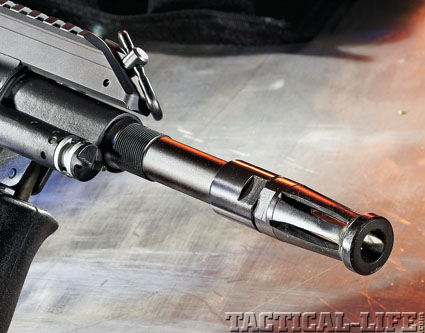
The cold-hammer-forged barrel features the classic “tulip” muzzle brake design. Note the two-position gas regulator left of the barrel.
After I finished up the accuracy testing, I filled up a few 30-round mags and the 42-rounder and tested the gun further for function. Over the span of a few hundred rounds, I only experienced an early minor hang-up—the action failed to lock open once on an empty mag. The handling and ergonomics of the rifle were excellent, and recoil was non-existent, mostly because of the design’s rear-oriented balance point as well as its 8.15-pound empty weight.
Final Thoughts
As with all Steyr products I have had the opportunity to shoot, I came away very impressed with the AUG/A3 SA. Its quality control was top notch, the fit and finish were superb, and its performance on the range was quite good. Accepting that an officer may want something a little more “out of the ordinary” than the prolific AR, the Steyr Arms AUG should provide a unique alternative. With the overall length of most SBR carbines, while still retaining a full 16-inch barrel, the AUG/A3 SA would make for an ideal entry tactical carbine for the SWAT officer or an outstanding patrol carbine. For more information, visit steyrarms.com or call 205-655-8299.

